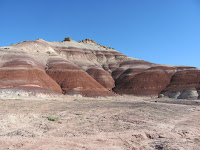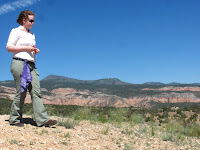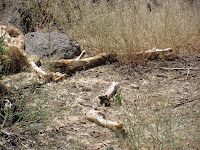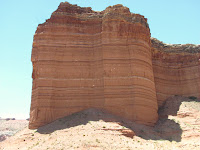
Part of our orientation as campground hosts was to tour the Cathedral Valley District with a ranger on one of our days off. This would allow us not only to have an expert guide showing us the way but also 4-wheel drive is definitely needed for this trek, something we don’t have. This was going to be an all day excursion to the north end of the park so packing a lunch and plenty of water was required. Our supervisor, Ranger Brenda, picked us up around 8am, and also accompanying us on this trip was Laura, a new archaeology intern.

The trip started by heading east on the main road that would take us outside the park where we crossed the Fremont River, which was running about 18 inches deep…a piece of cake for the Tahoe! We were still outside the park boundary for the next 10 miles or so, but the scenery was still amazing as we passed the Bentonite Hills. These hills are said to have been formed from volcanic ash during the Jurassic Period some 156 to 147 million years ago. Bentonite is a type of clay that is characterized by colorful layered bands, and these hills are truly something to see.



We stopped a couple of times along the way for photos, and once we reached the Upper South Desert Overlook, it was time to get out and stretch our legs. All of us walked part of the trail, but only Laura and I continued on to the top of the overlook. What a spectacular view!



Deep erosion has carved out this area of the backcountry called the Cathedral Valley because of the free-standing monoliths (or cathedrals) that seem to just crop up from the desert floor.
It was now about 11:30 and Brenda planned for us to enjoy our lunch at the Cathedral Valley Campground, another very

primitive campground like Cedar Mesa in the south with only 6 sites but far less fewer trees. We did manage to find some shade under a juniper and were shortly joined by Rangers Kyle (left) and Alex, who were doing routine patrol of the Cathedral District. Other than these two guys, we saw only one other car during this entire backcountry trip.

Back in the car we headed down a steep series of switchbacks into the Upper Cathedral Valley where the historic Morrell Cabin is located. It can be accessed by a short walking trail, but Brenda’s seen it plenty of times and Russ says he’s seen enough historic cabins so Laura and I

walked through the sagebrush to check it out. This cabin was built in the 1920s and originally stood several miles west of its current location. In 1932 Lesley Morrell bought the cabin, numbered each of the logs, dismantled it, and hauled the pieces down the mountainside in a horse-drawn wagon to be rebuilt on this site

. Over the next 40 years the cabin was used by cowboys annually moving their livestock. As a sign near the cabin reads “Western hospitality dictated that the cabin be kept furnished and stocked with food, open to all who needed shelter or a meal.” It was regularly used until the National Park Service purchased the property in 1970. Though the door was locked, we could peer through the windows and I was able to get a shot of a

table strewn with dust covered jars, cookware, and other items for the tired cowboy. Laura will be returning here as part of her job to inventory and update the condition of the cabin and its contents. As we walked past the corral, we noticed the remains of a large animal….a well-cleaned spine in one area and a leg with hoof intact in another area that was probably from a more recent kill since there was also quite a bit of fur laying around.

As we continued our drive, we passed several black vertical rocks that Brenda explained were basalt dikes and are what remain long after the soft sandstone around them has eroded away. In this picture you can actually see not only one stand alone dike but also where some are exposed through the sandstone and will one day also stand alone.

Brenda was leading us towards a specific area she wanted to show us known as the Gypsum Sinkhole that is 200-foot deep sinkhole and about 50 feet in diameter. Gypsum is an abundant mineral in the area, and this sinkhole was created when a plug of gypsum eventually diss

olved and collapsed under the weight of the overlying rock layers. I wasn’t able to get a photo of the entire thing partially due to it size, but also because it can be treacherous getting too close to the edge. As we walked back to the car, I was struck by the vastness and relative beauty of this region.

On the way to our next stop, Brenda pointed out the Layer Cake Wall, and by looking at it I’m sure you can see how it got its name. Don’t think we’ve ever seen any geological wonder so evenly layered!

One of the coolest things we saw on this trip was Glass Mountain. More of a mound than a mountain, it stands about 15 feet high and is actually an exposed plug of gypsum that formed as a result of the mineral being deposited about 165 million years ago from evaporating seawater and then crystallized. It’s no

w being exposed as the soft sandstone around it slowly erodes away…just another one of those geological marvels. Unfortunately vandals have also slowly chipped away at the crystals, and in such a remote area it’s hard to catch them in the act.

Of course the highpoint of any visit to the Cathedral Valley District is seeing the Temples of the Sun and Moon, massive sandstone monoliths that stand nearly 400 feet tall above the desert floor. Understanding the creation of these cathedrals, cliffs, valleys, and the entire surrounding area from ancient seas, volcanic ash, and ice ages over eons of times can be mind boggling, and its desolate, serene beauty seems almost other worldly.

Instead of making the normal 57-mile loop, Brenda had decided to backtrack some and make the return trip back through Fishlake National Forest. As we climbed the mountainous region over a series of switchbacks, we enjoyed some breathtaking views looking back at

the Cathedral Valley below. We covered about 150 miles on this trip, and Brenda was an excellent guide making the time fly. Capitol Reef is truly an amazing and diverse national park with so much to see.

No comments:
Post a Comment